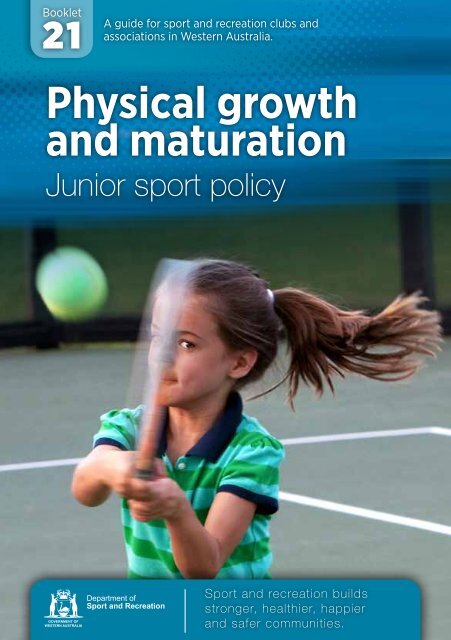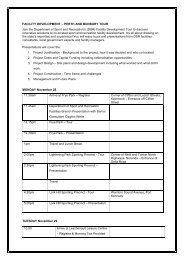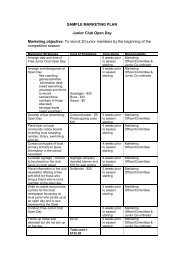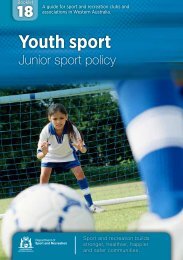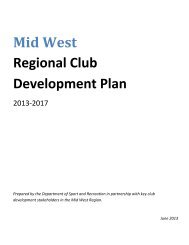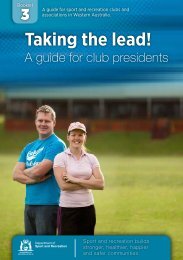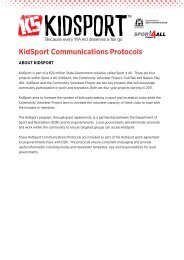Physical growth and maturation - ClubsOnline
Physical growth and maturation - ClubsOnline
Physical growth and maturation - ClubsOnline
You also want an ePaper? Increase the reach of your titles
YUMPU automatically turns print PDFs into web optimized ePapers that Google loves.
Booklet<br />
21<br />
A guide for sport <strong>and</strong> recreation clubs <strong>and</strong><br />
associations in Western Australia.<br />
<strong>Physical</strong> <strong>growth</strong><br />
<strong>and</strong> <strong>maturation</strong><br />
Junior sport policy<br />
Sport <strong>and</strong> recreation builds<br />
stronger, healthier, happier<br />
<strong>and</strong> safer communities.
Overview<br />
This booklet is part of a series covering<br />
the nine guidelines outlined in the Junior<br />
Sport Framework (JSF) as developed by<br />
the Australian Sports Commission (ASC).<br />
The information in this booklet has been<br />
reproduced with the permission of the ASC.<br />
The guidelines cover topics to address the<br />
needs of young people in sport <strong>and</strong> include:<br />
19 Long-term involvement.<br />
20 Getting young people involved.<br />
21 <strong>Physical</strong> <strong>growth</strong> <strong>and</strong> <strong>maturation</strong>.<br />
22 Sport pathways.<br />
23 Forming links.<br />
24 People making it happen.<br />
25 Quality coaching.<br />
26 Making sport safe.<br />
27 The law <strong>and</strong> sport.<br />
Introduction<br />
<strong>Physical</strong> activity is needed for normal <strong>growth</strong><br />
<strong>and</strong> development <strong>and</strong> for young people to<br />
reach their potential in muscle <strong>and</strong> bone<br />
development.<br />
Sport is an ideal way to provide this<br />
necessary activity, as it also brings<br />
psychological <strong>and</strong> social benefits to young<br />
people.<br />
For the best physical <strong>and</strong> skill development,<br />
consideration must be given to factors<br />
related to <strong>growth</strong> <strong>and</strong> <strong>maturation</strong> to help<br />
with decisions about grouping young people<br />
for participation <strong>and</strong> readiness for:<br />
• progressions in training <strong>and</strong> competition;<br />
<strong>and</strong><br />
• specialisation <strong>and</strong> intense training.<br />
These booklets outline the main points<br />
of the guidelines to assist in the delivery<br />
of best practice in junior sport <strong>and</strong> to<br />
encourage young people to make a life-long<br />
commitment to sport.<br />
A complete copy of the JSF is available on<br />
the ASC website: www.ausport.gov.au<br />
2
Developmental<br />
process<br />
The development of a child is driven by<br />
three distinct processes; <strong>growth</strong>, <strong>maturation</strong>,<br />
<strong>and</strong> adaptation. These have important<br />
implications for training <strong>and</strong> competition.<br />
Growth is the increase in overall body<br />
size with changes in muscle, bone <strong>and</strong><br />
fat <strong>and</strong> this affects motor skills. Growth is<br />
complicated because:<br />
• different parts of the body grow at<br />
different rates; <strong>and</strong><br />
• periods of <strong>growth</strong> start <strong>and</strong> stop at<br />
different times.<br />
Maturation is the genetically programmed<br />
series of changes leading to maturity.<br />
These changes occur in the same sequence<br />
in everybody, but there are great individual<br />
differences in:<br />
• when puberty starts;<br />
• how long it takes (it can be 18 months to<br />
five years); <strong>and</strong><br />
• how much <strong>growth</strong> occurs in the<br />
adolescent <strong>growth</strong> spurt.<br />
The <strong>growth</strong> spurt in height happens first <strong>and</strong><br />
is followed by the <strong>growth</strong> spurt in weight <strong>and</strong><br />
then the <strong>growth</strong> spurt in strength.<br />
Adaptation occurs as a result of external<br />
rather than genetic factors (e.g. intensive<br />
training).<br />
Implications for sport<br />
The uneven spread in <strong>growth</strong> <strong>and</strong> <strong>maturation</strong><br />
in young people of the same age makes<br />
chronological age of limited value in<br />
determining the developmental status of a<br />
young person. This creates challenges related<br />
to opportunity, training <strong>and</strong> competition.<br />
Opportunity<br />
Opportunities (e.g. being selected to<br />
participate) may not be offered to some<br />
young people because of their current<br />
developmental status. Therefore, sport<br />
providers must:<br />
• be aware that late maturing young<br />
people may be disadvantaged when<br />
competitions are based on chronological<br />
age; <strong>and</strong><br />
• encourage young people despite their<br />
current body shape as this may be<br />
different later on.<br />
Activities should be organised so young<br />
people have positive experiences regardless<br />
of their developmental status.<br />
Young people <strong>and</strong> their parents/carers<br />
should focus on personal improvement <strong>and</strong><br />
not comparison with others of the same age.<br />
The result is more young people having<br />
a chance to realise their potential <strong>and</strong><br />
expansion of the talent pool for future<br />
success in sport.<br />
3
Training/practice<br />
For the most part, training <strong>and</strong> sport activity<br />
is beneficial for the best possible physical<br />
<strong>growth</strong> <strong>and</strong> development of young people.<br />
However, it is important to remember that<br />
young people differ from adults in the quality<br />
of their tissues <strong>and</strong> are not able to take the<br />
same stresses.<br />
Consequently, training must be conducted<br />
differently for young people, particularly if<br />
they are specialising <strong>and</strong> involved in a narrow<br />
range of activities.<br />
Injuries do occur on occasions but are usually<br />
reversible. There are times during periods of<br />
<strong>growth</strong> when tissues are more vulnerable.<br />
For example, it takes considerable time for a<br />
bone that has lengthened to become strong<br />
<strong>and</strong> for the muscles, tendons <strong>and</strong> ligaments<br />
to grow to the new length of the bone.<br />
The most common problem is soft tissue<br />
injuries (muscles, ligaments <strong>and</strong> tendons)<br />
due to trauma or overuse. Rare problems<br />
include the risk of:<br />
• fractures, particularly during the <strong>growth</strong><br />
spurt when bones are lengthening <strong>and</strong><br />
are relatively porous; <strong>and</strong><br />
• injuries to the <strong>growth</strong> plate of bones<br />
caused by high contact forces or<br />
repetitive loading in some sports.<br />
One area of increasing concern is low bone<br />
density in adolescent girls in sports requiring<br />
leanness at the elite level (see Booklet 26<br />
of this Department of Sport <strong>and</strong> Recreation<br />
series, ‘Making sport safe – Junior sport<br />
policy’).<br />
The high-energy expenditure of intense<br />
training accompanied by restricted food<br />
intake can lead to menstrual dysfunction <strong>and</strong><br />
precipitate bone loss.<br />
This in turn increases the risk of:<br />
• stress fractures in the short-term; <strong>and</strong><br />
• osteoporosis in later life.<br />
Healthy eating with sufficient energy for<br />
training is important to prevent a negative<br />
impact on <strong>growth</strong> <strong>and</strong> <strong>maturation</strong>.<br />
For safety, young people in intense training<br />
should have qualified coaches who plan<br />
training <strong>and</strong> competition schedules<br />
according to individual needs. These should<br />
be:<br />
• designed around the holistic needs<br />
of young people with consideration<br />
of their level of social, emotional <strong>and</strong><br />
psychological <strong>maturation</strong>;<br />
• planned taking into account all physical<br />
activities undertaken by a young person;<br />
<strong>and</strong><br />
• Adjusted on an ongoing basis so loading<br />
is progressive <strong>and</strong> matched to their<br />
developmental stage.<br />
4
3.1 Strategies for<br />
accommodating <strong>growth</strong><br />
<strong>and</strong> <strong>maturation</strong> —<br />
training/practice<br />
• Plan <strong>and</strong> adjust training schedules based<br />
on individual <strong>growth</strong> <strong>and</strong> <strong>maturation</strong>.<br />
• Monitor for changes indicating a <strong>growth</strong><br />
spurt (e.g. faster increase in height, onset<br />
of menstrual cycle in girls <strong>and</strong> voice<br />
changes in boys, input from parents) <strong>and</strong><br />
alter training <strong>and</strong> competition based on<br />
individual needs.<br />
• Educate coaches <strong>and</strong> parents/carers on<br />
issues related to <strong>growth</strong> <strong>and</strong> <strong>maturation</strong><br />
of young people.<br />
• When under-eating is suspected in<br />
young people who are training intensely,<br />
seek professional advice on healthy<br />
nutrition.<br />
Competition<br />
Competition is an important part of sport<br />
because it provides challenge in applying,<br />
testing <strong>and</strong> developing skills.<br />
However, the great variation in children of<br />
the same age in physical aspects such as<br />
height, weight <strong>and</strong> strength results in the risk<br />
of injury <strong>and</strong> psychological distress when<br />
young people are unevenly matched.<br />
It may be necessary to consider groupings<br />
based on criteria other than age to favour<br />
a positive environment for young people<br />
continuing in sport.<br />
H<strong>and</strong>icapping is a way of allowing the<br />
participation in open competition of young<br />
people with disabilities, or who are smaller/<br />
not as strong as others.<br />
3.2 Strategies for<br />
accommodating <strong>growth</strong> <strong>and</strong><br />
<strong>maturation</strong> — competition<br />
• Focus on personal improvement, not<br />
comparison against others.<br />
• Consider the use-varied criteria for<br />
groupings (e.g. skill level, experience,<br />
body weight, rather than chronological<br />
age or gender).<br />
• Use h<strong>and</strong>icapping in competitions<br />
to reduce the effect of <strong>growth</strong> <strong>and</strong><br />
<strong>maturation</strong> differences.<br />
• Consider skills, physical <strong>maturation</strong> <strong>and</strong><br />
psychological development <strong>and</strong> allow<br />
boys <strong>and</strong> girls to participate together<br />
when these are similar.<br />
5
Talent development<br />
Some young people are started in hard<br />
training early (e.g. 5–8 years) in the belief this<br />
will increase the chances of developing an<br />
elite athlete.<br />
Early success does not predict success later<br />
on. Many world class adult athletes were not<br />
outst<strong>and</strong>ing as children.<br />
Expert opinion is that children 12 years <strong>and</strong><br />
under should be encouraged to participate in<br />
a wide range of activities requiring a variety<br />
of motor skills before beginning to specialise<br />
in a single sport, event or position.<br />
In this way, the athleticism of young<br />
people is improved <strong>and</strong> late developers are<br />
encouraged to stay in sports long enough<br />
to derive benefit <strong>and</strong> satisfaction from their<br />
eventual maturity.<br />
Some young people have the potential to<br />
become elite athletes <strong>and</strong> so may wish to<br />
train seriously. Their progress is best catered<br />
for by:<br />
3.3 Strategies for talent<br />
development<br />
• Focus on young people having fun so<br />
their interest is maintained until they are<br />
at an age <strong>and</strong> stage to specialise.<br />
• Leave talent identification <strong>and</strong><br />
development as late as possible.<br />
• Expose young people to as many<br />
different sporting experiences as<br />
possible (e.g. rotate positions <strong>and</strong><br />
teams).<br />
While achieving <strong>and</strong> responding to<br />
challenges, young people must also have fun.<br />
It is not in their best interest to have them<br />
concerned at an early age about whether<br />
they are going to make the elite ranks.<br />
This concern could manifest in overdoing<br />
training <strong>and</strong> competition <strong>and</strong> be counter<br />
productive. Let them enjoy moving up the<br />
pathways to success.<br />
• graduated talent development programs<br />
based on quality coaching <strong>and</strong> talent<br />
management;<br />
• physical, mental <strong>and</strong> emotional<br />
preparation for the dem<strong>and</strong>s of highlevel<br />
competition; <strong>and</strong><br />
• education about the societal role of elite<br />
athletes <strong>and</strong> the potential impact of<br />
success <strong>and</strong> failure on their lives.<br />
A well-rounded approach is needed so<br />
their educational <strong>and</strong> social needs are not<br />
compromised.<br />
Consideration should be given to the<br />
difficulty of predicting at an early age the<br />
success or otherwise of the future adult<br />
athlete.<br />
6
Key message<br />
Young people grow <strong>and</strong> mature at different rates. Underst<strong>and</strong>ing the implications of this can<br />
make sports participation more rewarding <strong>and</strong> safer for young people if sports providers:<br />
• adapt activities to their changing needs especially during periods of rapid <strong>growth</strong>;<br />
• judge performance according to a young person’s stage of development <strong>and</strong> not by what<br />
others of the same age can do; <strong>and</strong><br />
• leave decisions about specialisation as late as possible so best choices are made for the<br />
young person.<br />
Key points — <strong>growth</strong> <strong>and</strong> <strong>maturation</strong><br />
• Growth <strong>and</strong> <strong>maturation</strong> vary greatly in young people, making chronological age a poor<br />
indicator of developmental status.<br />
• Young people should be encouraged to participate in a wide range of sporting activities.<br />
• Late maturers <strong>and</strong> young people small for their age can be discouraged in sport <strong>and</strong> may<br />
not get a chance to develop their talent.<br />
• During <strong>growth</strong> spurts training <strong>and</strong> competition need to be planned carefully to avoid injury.<br />
• The risk of bone fracture, <strong>growth</strong> plate injuries <strong>and</strong> soft tissue injuries increases during<br />
rapid <strong>growth</strong>.<br />
• Girls who under-eat while training intensely run the risk of stress fractures <strong>and</strong>, in later life,<br />
osteoporosis.<br />
• Training <strong>and</strong> competition schedules need to be planned around the holistic needs of each<br />
individual athlete.<br />
• Early specialisation reduces athleticism (competence in a broad range of motor skills) <strong>and</strong><br />
can lead to early burnout.<br />
• Taking care of young people with regard to practice <strong>and</strong> training schedules <strong>and</strong> when they<br />
specialise in their sport, is important to keep young people in sport for the long-term <strong>and</strong><br />
to make sure no potentially talented young people are lost to the sport.<br />
7
Further reading<br />
Briefing paper<br />
21 Phycical <strong>growth</strong> <strong>and</strong> <strong>maturation</strong> –<br />
Junior sport policy.<br />
Case study<br />
Uncle Tobys GO Swim illustrates the use<br />
of ability rather than age to group young<br />
people for activities including competition.<br />
Resources<br />
American Academy of Pediatrics Policy<br />
Statement: Strength Training by Children <strong>and</strong><br />
Adolescents: www.aap.org<br />
Uncle Tobys GO Swim<br />
The Uncle Tobys GO Swim program is<br />
designed for young people aged 6–11 years<br />
to encourage them to become involved in<br />
the sport of swimming, once they have learnt<br />
to swim.<br />
Aims are to:<br />
• match young people according to their<br />
experience in the sport rather than age;<br />
• emphasise fun <strong>and</strong> learning skills; <strong>and</strong><br />
• introduce young people to competition<br />
with the focus on participation rather<br />
than winning.<br />
Special events form part of the Uncle Tobys<br />
GO Swim program <strong>and</strong> aim for all involved<br />
to have a positive experience. Included are<br />
technique races, where the GO Swimmers<br />
are judged on their technique rather than<br />
speed.<br />
General clinics are also conducted where<br />
skills are practised <strong>and</strong> improved. Care is<br />
taken to group children with others of similar<br />
ability.<br />
Uncle Tobys GO Swim is delivered by<br />
registered service providers who are qualified<br />
<strong>and</strong> experienced teachers/coaches. They<br />
work at a local level with swimming clubs<br />
to provide a pathway for the GO Swimmers<br />
once they move on from the program.<br />
Major objectives are to:<br />
• Give GO swimmers opportunities for fun<br />
in the sport.<br />
• Provide pathways for further<br />
involvement in either competitive or<br />
recreational sport.<br />
8
Other resources<br />
This resource is part of the Club Development Officer Scheme, which provides assistance to<br />
Western Australian sport <strong>and</strong> recreation clubs <strong>and</strong> organisations to become better managed,<br />
more sustainable <strong>and</strong> to provide good quality services to members <strong>and</strong> participants.<br />
Other resources in the series include:<br />
1 Step-by-step to starting a new club<br />
2 Planning for your club – The future is in your h<strong>and</strong>s<br />
3 Taking the lead! A guide for club presidents<br />
4 The key to efficiency – The club secretary<br />
5 Show me the money – A guide for the club treasurer<br />
6 Effective club meetings – A guide for the chairperson<br />
7 Take the ‘in’ out of ineffective – 10 steps to running successful meetings<br />
8 Lighten the load <strong>and</strong> delegate – Help for the overworked committee member<br />
9 You have the answers – Solving club problems<br />
10 Marketing <strong>and</strong> promoting your club<br />
11 Sponsorship – Seeking <strong>and</strong> servicing a sponsor<br />
12 Establishing your club constitution <strong>and</strong> becoming incorporated<br />
13 Risky business – A club guide to risk management<br />
14 Clubs’ guide to volunteer management<br />
15 Member protection for clubs<br />
16 How to be more inclusive of people from diverse backgrounds<br />
17 Passport into schools – Linking sports with schools<br />
18 Youth sport – Junior sport policy<br />
19 Long-term involvement – Junior sport policy<br />
20 Getting young people involved – Junior sport policy<br />
21 <strong>Physical</strong> <strong>growth</strong> <strong>and</strong> <strong>maturation</strong> – Junior sport policy<br />
22 Sport pathways – Junior sport policy<br />
23 Forming links – Junior sport policy<br />
24 People making it happen – Junior sport policy<br />
25 Quality coaching – Junior sport policy<br />
26 Making sport safe – Junior sport policy<br />
27 The law <strong>and</strong> sport – Junior sport policy<br />
28 Top 20 tips for officials<br />
29 Top 20 tips for successful coaching<br />
You will find the full series of the booklets on the Department of Sport <strong>and</strong> Recreation’s<br />
<strong>ClubsOnline</strong> website: www.dsr.wa.gov.au/clubsonline<br />
9
<strong>ClubsOnline</strong><br />
<strong>ClubsOnline</strong> www.dsr.wa.gov.au/clubsonline is the place for sport <strong>and</strong> recreation clubs in<br />
Western Australia to communicate with other clubs, the Department of Sport <strong>and</strong> Recreation<br />
<strong>and</strong> Club Development Officers. It provides clubs with an opportunity to share ideas <strong>and</strong><br />
access useful club-related resources.<br />
Some of the resources you will find on <strong>ClubsOnline</strong> include:<br />
• Find a Club, which helps you search for <strong>and</strong> contact clubs in your area.<br />
• Free club website. Simply register with Find a Club <strong>and</strong> your club will be eligible for its<br />
own simple-to-build website.<br />
• Club self assessment tool.<br />
• Volunteers exchange to browse for ‘clubs seeking volunteers’ or post your own notice<br />
under ‘volunteers seeking clubs’.<br />
• Find my Club Development Officer. The Club Development Officer Scheme is a<br />
partnership with local governments across Western Australia to build the capacity<br />
of community-based clubs. A statewide network of Club Development Officers<br />
assists, supports <strong>and</strong> develops community based sport <strong>and</strong> recreation clubs through<br />
education, facilitation <strong>and</strong> communication.<br />
• Clubhouse resources including booklets, useful documents to download <strong>and</strong> a<br />
selection of podcasts.<br />
10
Notes<br />
11
Metropolitan<br />
246 Vincent Street<br />
Leederville<br />
PO Box 329, Leederville WA 6903<br />
Telephone (08) 9492 9700<br />
Facsimile (08) 9492 9711<br />
Email info@dsr.wa.gov.au<br />
Gascoyne<br />
4 Francis Street, Carnarvon<br />
PO Box 140, Carnarvon WA 6701<br />
Telephone (08) 9941 0900<br />
Facsimile (08) 9941 0999<br />
Email gascoyne@dsr.wa.gov.au<br />
Goldfields<br />
106 Hannan Street, Kalgoorlie<br />
PO Box 1036, Kalgoorlie WA 6430<br />
Telephone (08) 9022 5800<br />
Facsimile (08) 9022 5899<br />
Email goldfields@dsr.wa.gov.au<br />
Great Southern<br />
22 Collie Street<br />
Albany WA 6330<br />
Telephone (08) 9892 0100<br />
Facsimile (08) 9892 0199<br />
Email greatsouthern@dsr.wa.gov.<br />
au<br />
Kimberley<br />
Broome<br />
Unit 2, 23 Coghlan Street, Broome<br />
PO Box 1127, Kununurra WA 6743<br />
Telephone (08) 9195 5750<br />
Facsimile (08) 9166 4999<br />
Email kimberley@dsr.wa.gov.au<br />
Kununurra<br />
Government Offices<br />
Cnr Konkerberry Drive<br />
<strong>and</strong> Messmate Way, Kununurra<br />
PO Box 1127, Kununurra WA 6743<br />
Telephone (08) 9166 4900<br />
Facsimile (08) 9166 4999<br />
Email kimberley@dsr.wa.gov.au<br />
Mid West<br />
Mid West Sports House<br />
77 Marine Terrace, Geraldton<br />
PO Box 135, Geraldton WA 6531<br />
Telephone (08) 9956 2100<br />
Facsimile (08) 9956 2199<br />
Email midwest@dsr.wa.gov.au<br />
Peel<br />
Suite 3, The Endeavour Centre<br />
94 M<strong>and</strong>urah Terrace, M<strong>and</strong>urah<br />
PO Box 1445, M<strong>and</strong>urah WA 6210<br />
Telephone (08) 9550 3100<br />
Facsimile (08) 9550 3199<br />
Email peel@dsr.wa.gov.au<br />
Pilbara<br />
2/3813 Balmoral Road, Karratha<br />
PO Box 941, Karratha WA 6714<br />
Telephone (08) 9182 2100<br />
Facsimile (08) 9182 2199<br />
Email pilbara@dsr.wa.gov.au<br />
South West<br />
80A Blair Street, Bunbury<br />
PO Box 2662, Bunbury WA 6231<br />
Telephone (08) 9792 6900<br />
Facsimile (08) 9792 6999<br />
Email southwest@dsr.wa.gov.au<br />
Wheatbelt<br />
Northam<br />
298 Fitzgerald Street, Northam<br />
PO Box 55, Northam WA 6401<br />
Telephone (08) 9690 2400<br />
Facsimile (08) 9690 2499<br />
Email wheatbelt@dsr.wa.gov.au<br />
Narrogin<br />
Government Offices<br />
Level 2, 11–13 Park Street, Narrogin<br />
PO Box 54, Narrogin WA 6312<br />
Telephone 0429 881 369<br />
Facsimile (08) 9881 3363<br />
Email wheatbelt@dsr.wa.gov.au


